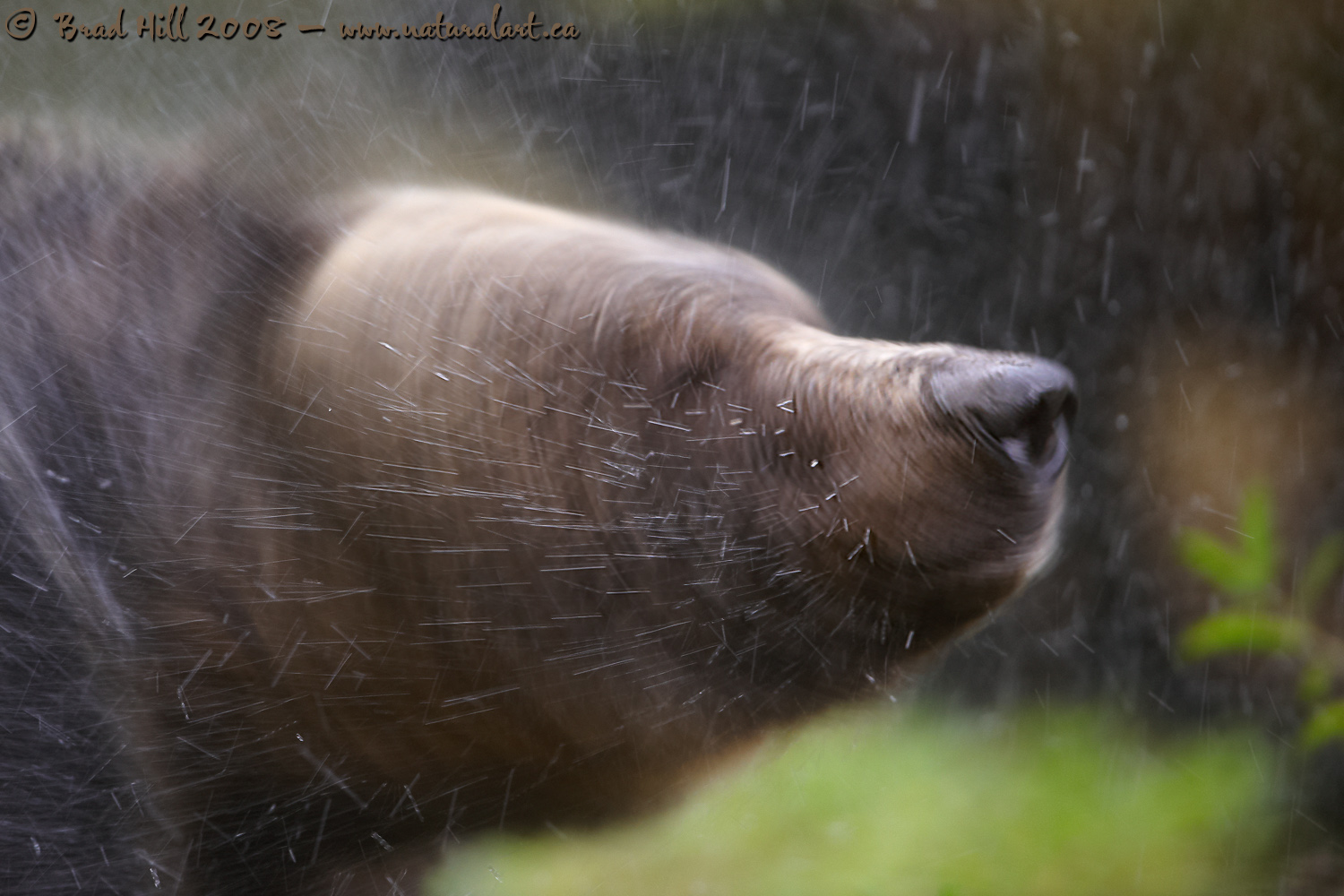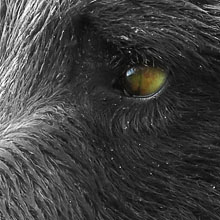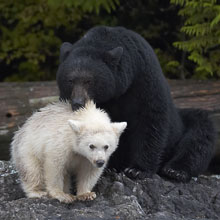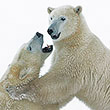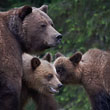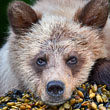Availability: Undetermined - Enquiries?
In the Field
Surreal Shaking. Great Bear Rainforest (northern BC coast). October 7, 2008.
Just a fun shot of an adult grizzly shaking water off its face after doing a little salmon-seeking head dunking...
When capturing any form of movement or action found in nature, photographers face a creative decision: should they freeze the action or blur it? Both approaches can work well and often times the lighting regime will be such that both options are open to the photographer (especially with today's superb high ISO performers like the Nikon D3 or D700). Interestingly, it could be argued that NEITHER approach will produce an image that accurately mimics what our eye/brain perceived in the field, though most people tend to think the "freeze the action" approach more closely approaches what humans perceive as reality.
I won't deal with why you choose one approach over the other in this commentary - I'll stick with some tips surrounding the "how" of freezing and blurring motion. Most everyone reading this probably already knows that the freezing vs. blurring issue is tightly coupled to the shutter speed you capture the image with: higher shutter speeds move you toward freezing the action while lower shutter speeds assist in blurring the action. So...what shutter speeds do you need to successfully achieve your goal? Turns out that there's more than a few things to consider...
1. The ol' "Pixels Crossed per Unit Time" Issue. A critically important thing to consider when choosing a shutter speed to use to freeze or blur action is how many photosites on your light sensor the subject is crossing per unit time. This varies with a number of things, including the speed the subject is moving and, equally as importantly, how much of your viewfinder/sensor the subject is occupying. So, if the object is close and filling the majority of your viewfinder, even at moderately low speeds it will cross many photosites in a given amount of time - thus requiring a very high shutter speed to "freeze" the action (but making it VERY easy to blur). Conversely, a very fast moving object that is tiny in your viewfinder crosses far fewer pixels/photosites per unit time and can be frozen with only moderately fast shutter speeds. The take-home lesson: The larger the subject in your viewfinder, the faster the shutter speed needed to freeze the action (but the easier it is to blur). Look at the image above - the bear's head virtually fills the frame (this is pretty much a full-frame image) and even at 1/80s the image shows an extreme motion blur. I would have needed a VERY fast shutter speed (probably close to 1/2000s or quicker) to freeze this action.
2. The ol' "Direction of Travel" Issue. Another thing to keep in mind (and actually another manifestation of the pixels per unit time issue) is the direction of travel of the subject. If the subject is moving parallel to your sensor (so across the viewfinder) it crosses more photosites per unit time than if it is moving directly toward (or away) from your camera. So...you will require higher shutter speeds to freeze subjects moving across your viewfinder than those moving directly at or away from you. An example? Check out the water droplets (the white streaks) in the image above - all the longer (more blurred) streaks are those moving across (parallel) the viewfinder than the ones moving AT or AWAY from the sensor (like the smaller ones near the nose). We WON'T get into the issue of the conical nature of the bear's head and how that impacts on the speed of the water droplets!
3. Uhhh..some shutter speed guidelines please? Okay...in MOST cases, but still subject to modification based on the issues above, you're likely to freeze MOST action at shutter speeds of 1/1000s or faster. And, you're very likely to blur action at shutter speeds of 1/60s or slower. Between 1/60s and 1/1000s? Sorry, issues #1 and #2 (above) become so critical in this shutter speed range that it is impossible to generalize...
ADDITIONAL NOTES:
1. This image - in all resolutions - is protected by copyright. I'm fine with personal uses of them (including use as desktop backgrounds or screensavers on your own computer), but unauthorized commercial use of the image is prohibited by law. Thanks in advance for respecting my copyright!
2. This image was captured during one of my autumn "Into the Great Bear Rainforest" photo tours in 2008. Each year I offer trips into two different parts of the Great Bear Rainforest as well as one to photograph marine mammals and oceanscapes near the northern tip of Vancouver Island. And, in selected years, I also offer photo tours to additional locations to capture other highly sought-after subjects, such as various boreal owl species, fishing grizzlies, and more. Details about these trips can be found on the Photo Tours page of this website.
3. Like all wildlife images on this website, the subject(s) is/are fully wild and completely unconstrained. Besides the potential impact of my/our presence, nothing has been done to intentionally alter or affect the ongoing behavior of the subject and, of course, there has been no use of any form of bait or other form of wildlife attractants (including vocalizations or other sounds).
Behind the Camera
Surreal Shaking. Great Bear Rainforest (northern BC coast). October 7, 2008.
Digital Capture; Compressed RAW (NEF) 14-bit format; ISO 900.
Nikon D700 with AF-S Nikkor 600mm f/4G IF-ED II VR lens supported on Gitzo 1348 carbon fibre tripod with Wimberley head. VR turned to "On" and in "Normal" mode. Autofocus set to M/a mode.
1/80s @ f4; -0.67 stop compensation from matrix-metered exposure setting.
At the Computer
Surreal Shaking. Great Bear Rainforest (northern BC coast). October 7, 2008.
RAW Conversion to 16-bit TIFF, including first-pass/capture sharpening, white balance adjustment, and noise reduction using Phase One's Capture One Pro 4.5.
Further digital corrections on 16-bit TIFF file using Adobe's Photoshop CS4. Adjustments included selective colour saturation and selective sharpening for web output.
Conservation
Surreal Shaking. Great Bear Rainforest (northern BC coast). October 7, 2008.
Ten percent of the revenue generated by this image will be donated to Raincoast*.
Species Status in Canada**: Special Concern (May 2002).
While Grizzly Bears (Ursus arctos) are not technically listed as "Endangered" in Canada, they have been extirpated from most of their historical range. Grizzly Bears are far more sensitive to intrusion/disturbance in their habitat than are Black Bears and are being increasingly forced into marginal habitat by human encroachment. The Great Bear Rainforest along the central and northern coast of British Columbia is one of the last strongholds of the Grizzly Bear in Canada, and even this population is coming under increasing pressure.
On December 18, 2017 the government of British Columbia banned grizzly hunting across the entire province. This major conservation victory came after decades of tireless work by many dedicated conservationists and ecologists and, most importantly, it reflects the opinion of the vast majority of British Columbians. And, it means that AT LEAST while the current government remains in power grizzlies are finally "safe" in British Columbia.
Now that we've at least temporarily won the battle to save grizzlies in BC, it's time to re-focus our efforts toward protecting ALL of BC's carnivores, including Gray Wolves, Black Bears, Cougars, Wolverines, and more! Simply put, there are no ecological, economic, or ethical arguments supporting the trophy hunting of carnivores.
In a great first step towards ending the hunting of carnivores throughout BC the Raincoast Conservation Foundation has developed a program designed to protect ALL carnivores within the Great Bear Rainforest. Details about this program can be found on this page on Raincoast's website. Check it out and, better yet, make a donation to help Raincoast purchase the remaining commercial hunting tenures in the Great Bear!
*The Raincoast Conservation Society (and Foundation) is an effective and efficient organization that has been fighting for protection of this unique habitat. If you are looking for a meaningful way to contribute to the conservation of this amazing ecosystem, Raincoast will provide maximal "bang" for your conservation dollars.
**as determined by COSEWIC: The Committee on the Status of Endangered Wildlife in Canada












